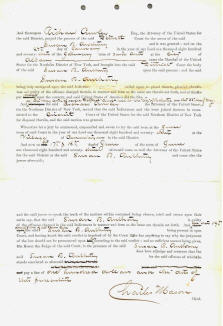What Did Susan B Anthony Think Needed To Be Changed
Susan B. Anthony and the Struggle for Suffrage
Susan B. Anthony and the Struggle for Suffrage
- Description
- Document
- Discussion Questions
- Extension Activities
- Standards
- Additional Resources
- Contact Us
Description
Susan B. Anthony devoted more than than fifty years of her life to the crusade of woman suffrage. After casting her ballot in the 1872 Presidential election in her hometown of Rochester, New York, she was arrested, indicted, tried, and convicted for voting illegally. At her two-twenty-four hours trial in June 1873, which she later described as "the greatest judicial outrage history has always recorded," she was convicted and sentenced to pay a fine of $100 and court costs.
After Anthony'due south arrest, which occurred two weeks after the Nov five election, there was a hearing to decide if she had, in fact, cleaved the law. The iii young men who registered her as a voter on November ane, 1872, and accepted her ballot at the polls on Election Day were interviewed at the hearing.
(Information cited from Eyewitness: American Originals from the National Archives)
Documents
Discussion Questions:
- According to the indictment, for what crime was Susan B. Anthony existence charged?
- According to the transcript, how did Susan B. Anthony protest her lack of suffrage? How does information technology compare and contrast to other protesters in history?
- How did Susan B. Anthony specifically justify her claim to suffrage, according to the testimony of Beverly Jones?
- How would you describe Susan B. Anthony's ain testimony? How does she describe her reasoning for voting?
Extension Activities
- Connections to Today: Beyond voting rights, what are other rights and freedoms that women take fought and continue to struggle to achieve?
- Sequencing Skill: Make a timeline that lists the 10 most important events in the suffrage movement between the Seneca Falls Convention and the passage of the 19th Amendment. Explain your choices.
- Creative Writing Activity: Using information from this case, write a periodical entry from the indicate of view of Susan B. Anthony or ane of the other participants. How do you call up they felt near the facts of the example?
Standards
- National History Standards
- Era 7: The Emergence of Modern America (1890-1930)
- Standard 1C: The student understands the limitations of Progressivism and the alternatives offered by various groups.
- NY Standards
- SS1.C.1. The study of New York Country and United states of america history requires an analysis of the development of American culture, its variety and multicultural context, and the means people are unified past many values, practices, and traditions.
- SS1.C.3. Report about the major social, political, economical, cultural, and religious developments in New York Country and United States history involves learning about the important roles and contributions of individuals and groups.
- NJ Standards
- half-dozen.1.12.A.6.b Evaluate the ways in which women organized to promote authorities policies (i.e., abolition, women's suffrage, and the temperance motility) designed to address injustice, inequality, workplace condom, and immorality.
- 6.1.12.D.half dozen.c Analyze the successes and failures of efforts to expand women's rights, including the piece of work of of import leaders (i.e., Elizabeth Cady Stanton, Susan B. Anthony, Alice Paul, and Lucy Stone) and the eventual ratification of the 19th Amendment.
Additional Resources:
- Susan B. Anthony Criminal Case File, 01/1873 - 07/1873
- NARA Resources on Women
- Susan B. Anthony, Accused (Library of Congress)
- Remarks by Susan B. Anthony in the Circuit Court of the United states of america for the Northern District of New York (The Elizabeth Cady Stanton and Susan B. Anthony Papers Project)
- Famous American Trials: The Trial of Susan B. Anthony (University of Missouri-Kansas City, School of Law)
If a teacher finds unique and effective ways to use these documents in their classroom and would like to share them with other teachers, please contact christopher.zarr@nara.gov
Source: https://www.archives.gov/education/lessons/suffrage.html
Posted by: wilsonmarmyre.blogspot.com

 U.S. vs. Susan B. Anthony, Record of Conviction, 06/28/1873 Susan B. Anthony Criminal Instance File, 01/1873 - 07/1873 Criminal Cases Heard in the U.S. Commune Court for the Northern District of New York, compiled 1870 - 1968 Record Grouping 21: Records of District Courts of the U.s.a., 1685 - 2004 National Archives Identifier 278304
U.S. vs. Susan B. Anthony, Record of Conviction, 06/28/1873 Susan B. Anthony Criminal Instance File, 01/1873 - 07/1873 Criminal Cases Heard in the U.S. Commune Court for the Northern District of New York, compiled 1870 - 1968 Record Grouping 21: Records of District Courts of the U.s.a., 1685 - 2004 National Archives Identifier 278304
0 Response to "What Did Susan B Anthony Think Needed To Be Changed"
Post a Comment